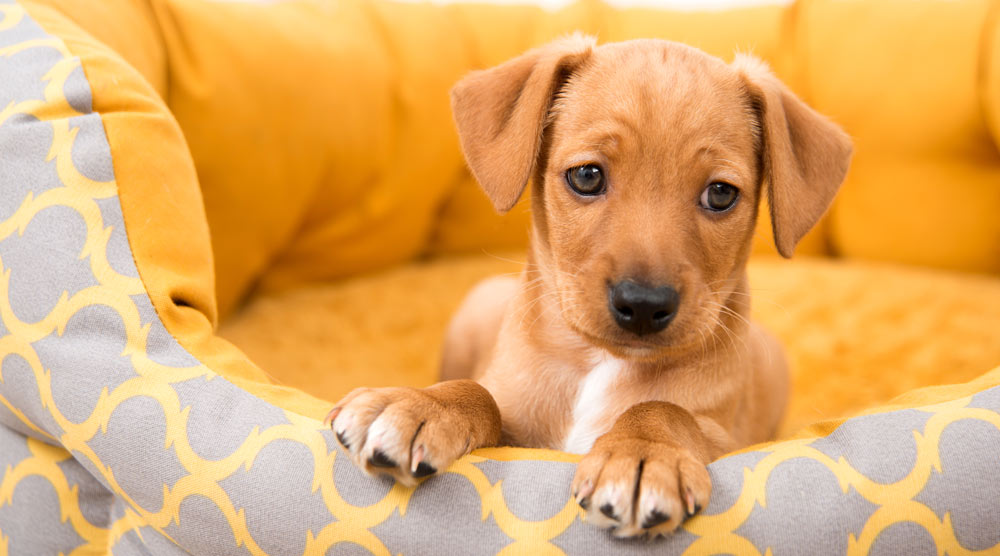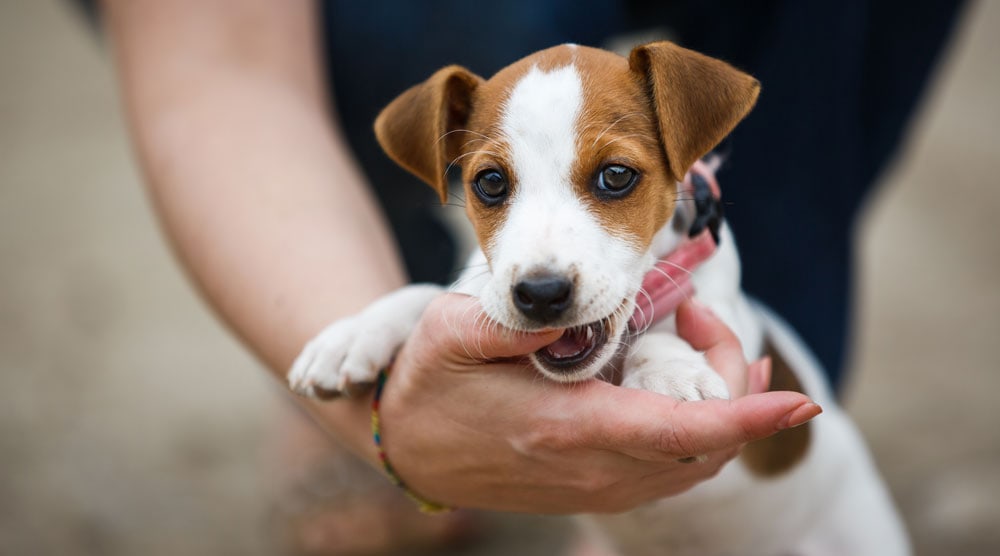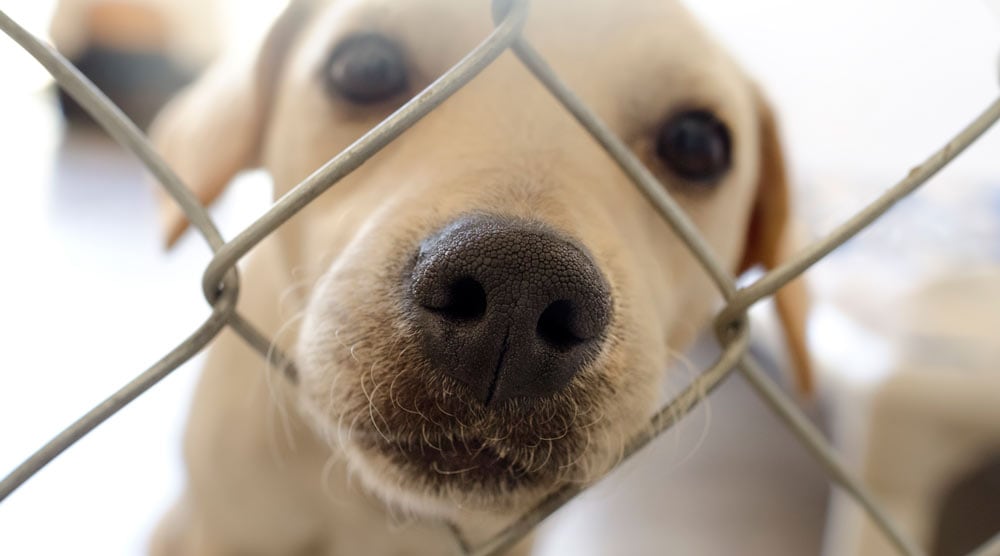As exciting as it can be to welcome a puppy into your home, it’s easy to become overwhelmed with the demands of a new family member. Read on for tips on how to manage the first week of your puppy’s new life with you.
Contents
When the realities of raising a puppy hit home, however, many owners can’t help but slightly panic! Puppies are a lot of work, have endless energy, and seem to be a magnet for mischief.
The good news is that there are many ways to make the first weeks easier. By being prepared and knowing what to expect, it’s easier to stay calm and help your puppy to settle in more quickly. Here’s our complete guide to the first week!
Preparing for Your Puppy’s First Days at Home
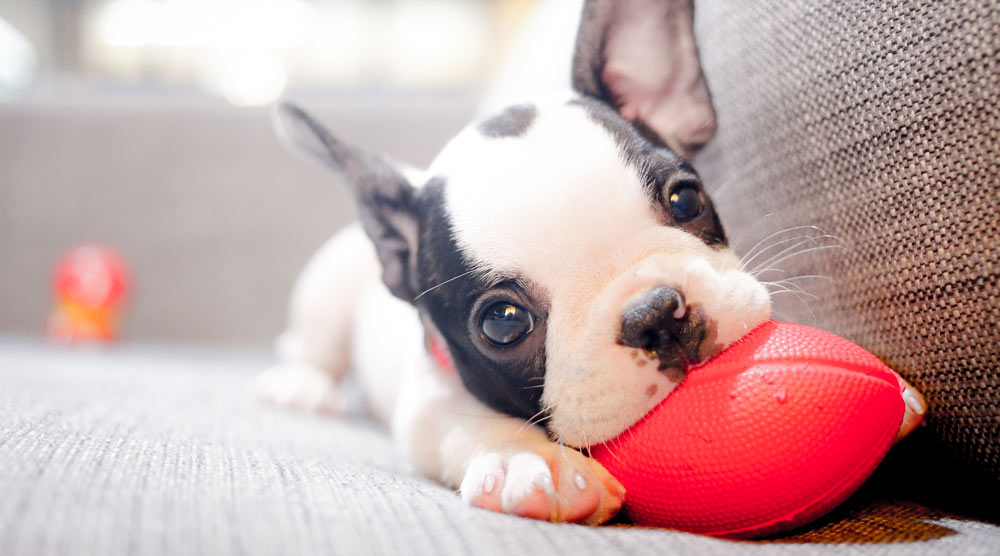
The first weeks and months play a big part in your puppy’s development. Putting in the groundwork in terms of routines, socialization, and initial training will set them up for future success. It’ll help keep your blood pressure down too!
Be Prepared and Know What to Expect!
It’s important to recognize what a huge change the first days in your home will be for your puppy. You can’t expect them to naturally know the “right” way to behave, or instantly form a bond with everyone in the house.
By doing your research and preparing in advance, you’ll know what to expect and be in a better position to react in a positive way.
It’s easy to underestimate a puppy’s energy levels, for example, or how their inquisitive nature can get them into trouble. Jumping up, toilet accidents, barking, nipping, and other common puppy behaviors should also be expected.
Preparing your home also reduces the chance of the pup having accidents on your favorite rug or chewing up your kid’s beloved teddy. And, if they do, at least you won’t have unrealistic expectations about having a ‘perfect puppy’. You’ll be ready to apply management and positive training techniques to guide your puppy towards behaviors we see as more appropriate.
Taking on a pup isn’t just an investment of time, it’s not cheap either. You should be prepared for the outlays involved in purchasing the required gear, vet bills, and potential dog walking or boarding costs. Doing this in advance helps prevent any nasty financial surprises.
Buy Essential Puppy Items
Stocking up on key pieces of kit in advance of your pup’s arrival will save you panic buying at the last minute.
Apart from the obvious things, like food and treats, you’ll need gear for walks, sleeping, cleaning, grooming and health. Making sure you have a variety of safe and durable puppy toys for additional enrichment and redirection is also key.
Purchasing a crate and taking the time to positively introduce it to your pup is a worthwhile investment. As well as offering a secure and safe sleeping space, it can help with toilet training through the night.
Check out our new puppy checklist article (or use this direct download link to the new puppy checklist) for in-depth advice on what to have ready for your pup’s arrival.
Make Sure All Family Members Are on the Same Page
It’s worth having a family meeting to run through some of the key protocols you plan to adopt when your puppy arrives.
Consistency is vital when it comes to helping your pup understand what you expect from them. If everyone takes a different approach, it’ll be confusing and potentially stressful for the dog, and it’ll take longer to master the basics.
Agreeing on how you plan to handle toilet training, jumping up, puppy nipping and barking are just a few examples of things worth discussing. You could come up with a list of guidelines which will be easy for everyone to refer back to.
Adopting positive reinforcement training techniques as a family will ensure your pup will develop a strong bond with you all. By rewarding the pup for the behavior you’re looking for, they’ll also be more likely to master things like pottying outside more quickly.
Tip: If you have children, a family rota for doggy duties can help to prevent arguments. Your kids will also feel involved and your pup will be less likely to miss out on essential pee breaks and feeding times.
Puppy Proof the House And Garden
Curious puppies get into everything. Puppy proofing your house and garden and decluttering will make it a safer environment for them. Plus, it means they’ll have fewer opportunities to practice undesirable behaviors.
Some of the key considerations include:
- Safely lock away any chemical products in your kitchen, garage and bathroom
- Keep kitchen work surfaces clear, especially from foods that are toxic to dogs
- Trash containers should be securely sealed or stored away
- Cover or tidy away trailing electrical cables as they can be enticing to chew on
- Don’t leave tempting clothes or shoes lying around. Puppies often select shoes as chew toys, which can reinforce bad habits and potentially be dangerous.
- Remove expensive rugs to prevent the chance of them being peed on or chewed
- Remove or reposition toxic plants (there are a surprising number of plants that are dangerous to dogs!)
- Secure the garden area by checking fences and blocking off escape points
Create a Comfortable Den for Your Pup
Making sure your pup has a safe, quiet and comfortable space to rest and relax is crucial. It’s especially helpful for encouraging them to settle at night.
Providing it’s introduced in the right way, a crate can be the most practical option. Furnish the crate with cozy blankets or a snug bed, then drape a blanket over it to give it a den-like feel.
Having your pup sleep in the crate at night means you don’t have to worry about them hurting themselves or getting up to mischief. It can also help with toilet training, as they’re less likely to potty in their sleeping area.
Working on ensuring your pup associates the crate with positive things from as soon as they arrive home is essential.
It’s a good idea to feed them their meals in it, and, whenever they go near it or in it, be sure to throw them a tasty treat. Offering a stuffed treat toy inside the crate can also build up positive associations and encourage them to settle in it. Don’t just stick your pup in, close the door and expect them to feel relaxed.
If you have a larger breed puppy and want to buy a crate big enough for them to grow into, make sure it has a divider. This allows you to make the space smaller in those first weeks, which minimizes the chance of the puppy using a corner as a potty area.
Never treat the crate as somewhere to put your pup when they’re naughty. If it becomes a punishment tool, negative associations can form, and your pup won’t want to use it.
Your puppy shouldn’t be cooped up in the crate for long periods during the day either. If you’re worried about them having unsupervised access in the house, a more spacious puppy pen or portable dog fence is a convenient alternative.
Register Your Puppy With a Local Vet
If you have several vets in your area, don’t just select the closest one. It’s sensible to take the time to read reviews, find out about their facilities, look at pricing and even visit in advance.
Ideally, you’ll want a vet that uses low-stress handling techniques to help your pup stay as relaxed as possible when they visit.
Registering in advance will allow you to enquire about vaccinations, neutering and parasite treatments.
Take Time Off Work
Booking some ‘pawternity leave’ is essential for helping your puppy settle during the first few weeks. It’s always hard for a puppy to leave their littermates and mother, but spending time with their new family helps the puppy to relax.
There are also practical reasons to take time off work. You can gradually introduce alone time to reduce the chance of separation anxiety, master house training much faster, and use the time together as a great opportunity to bond.
Note: If you work full-time and there’s no-one else around during the day, be honest about whether adopting a dog is the right decision. It’s unfair to leave dogs at home all day, as they are social animals who become stressed and anxious when alone.
Understand Positive Training and Management Strategies
Even if you aren’t doing any formal training in those first few days, understanding how positive reinforcement works is essential.
There are two main tools in the positive training toolbox: rewards and management.
Rewards teach your dog that they have done something right. They should be provided as quickly as possible after the desired behavior, so the puppy starts to link that behavior with a positive reward. Some examples of things you might want to reinforce include:
- Pottying outside
- Keeping all four paws on the floor rather than jumping
- Not barking when the doorbell rings
- Settling in the crate
It doesn’t always have to be food rewards either. In some circumstances, praise, attention or playing with a toy will be an appropriate reward.
On the other hand, you should never punish your dog for behavior you don’t want. Punishment can make your dog fearful and damages your bond. The dog often doesn’t understand why they are being punished and doesn’t know what to do instead.
Instead, try to manage your dog and minimise the chances he has to practice unwanted behaviors. For example, you might install a baby gate to prevent your dog running upstairs, or make sure that your children put their toys away so the puppy doesn’t have a chance to chew them. Crates or playpens can also keep your dog out of mischief when you can’t watch him.
When your pup does perform an unwanted behavior, such as jumping up, the best reaction is to ignore him to avoid providing accidental reinforcement.

The 3-3-3 Rule
The Rule of Three is often discussed when bringing home a rescue dog. It reminds owners not to expect their new dog to just slot into the family with no issues. It can take time for a dog to start to feel relaxed and settled in their new home.
While this process is typically quicker for puppies, the stages can still be similar:
- 3 days. Your pup could still be feeling overwhelmed and scared. They may not have a great appetite and could choose to hide in their crate or bed.
- 3 weeks. Your puppy will be starting to feel more at home. Their true personality could be starting to shine through, and they’ll be getting used to the household routines. This is the time when new challenging behaviors can start to surface.
- 3 months. Your puppy is likely to be feeling truly secure in their new home now, and strong bonds will have developed with their family members.
The First Day
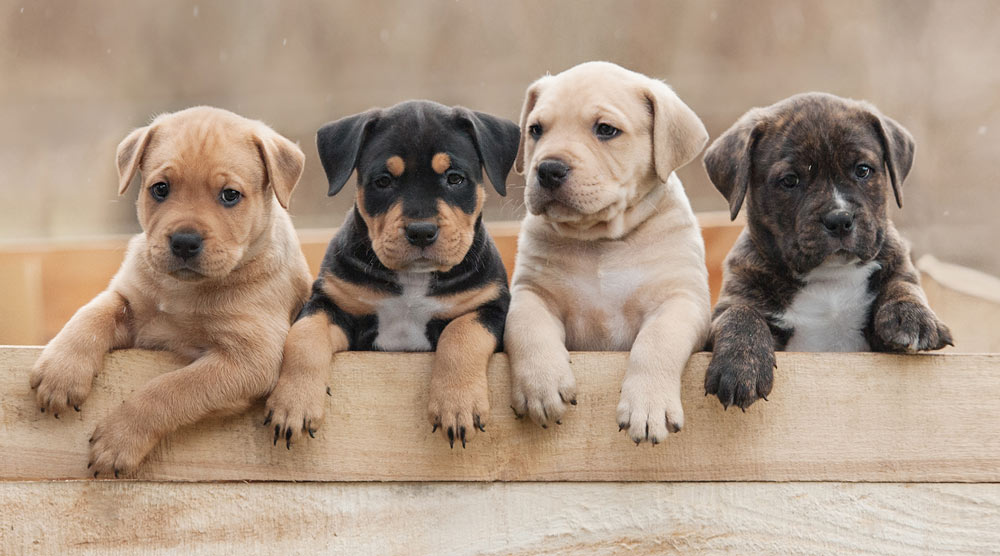
Each puppy will be different in terms of how they react to their new home on the first day. While they might be excited, they could also feel nervous and unsettled. Being consistent from the start and not asking too much of them can help them to settle in more quickly.
Collect Your Puppy!
Going over the serious stuff with the breeder in advance of collection can save you missing anything important when you’re excited. This includes worming schedules, vaccinations, feeding schedules, socialization, and any toilet training.
If you’re able to collect your puppy early in the day, this gives them a chance to adjust a bit more before everyone tries to settle down for the night.
Be mindful that the puppy has just been taken from the only environment they’ve ever known, including their mother and littermates. While their behavior may seem excited, the puppy will also feel stressed and anxious.
This is why calm introductions on arrival in the house are so important, especially when you have kids. Make sure they know to let the pup approach on their terms and that they need to be quiet and gentle.
They shouldn’t be continually picking the pup up, and restraining cuddles should be discouraged. Too much excitement or invasion of their space can be overwhelming.
Start Toilet Training as Soon as You Arrive Home
Give your pup the opportunity to go potty as soon as they arrive home. They may have had a long journey, and you won’t necessarily know when they last drank or relieved themselves before you collected them (unless they had an accident in the car!)
The fewer chances they have to potty inside or away from a puppy pad, the quicker they’ll master toilet training.
Go out armed with some super tasty treats and be patient. When they start to wee, you could add a verbal cue like “go potty” that can be used going forward. Make sure you reward them with yummy treats immediately after they have finished.
Don’t stress if your pup doesn’t go immediately. Remember, the garden will be a stimulating, distracting environment, and they may not be ready to go. If your pup is feeling stressed, they may be less inclined to be able to go potty too.
Just make sure you take them out at regular intervals after that. Generally, once every hour is a good place to start, and after every meal and nap.
Taking them out this often may seem excessive, but the goal is to do it more than necessary as this will minimize the chance of them going in the wrong place.
Make sure you don’t initiate play or other distracting activities in the garden until after they have gone to the potty. Don’t get distracted on your phone or talking to a neighbour either. You don’t want to miss the chance to reward them for going in the right place.
If your pup has an accident in the house, don’t punish them. Depending on the timing, they may not associate the accident with you yelling. Even if they do, it could make them frightened to potty in front of you, and they may seek a quiet spot to toilet in the house instead.
Tip: Frequent potty breaks also reduce the risk of your dog regressing as they begin to understand where to toilet.
Help Your Dog to Feel Relaxed
Puppies are generally adaptable, and, with time, they adjust to their new home. Taking steps to help your puppy feel more relaxed can move along this period of adjustment more successfully.
We’ve already mentioned the importance of a comfortable den and avoiding too much excitement and overstimulation.
Giving your pup time to explore their new environment at their own pace is also important. You should only offer affection or playtime when it’s sought, rather than forcing it upon them, as this reduces anxiety levels.
Don’t be tempted to have visitors during the first few days. Your pup needs quiet bonding time with their immediate family first.
Supervise Your Puppy at All Times
Keeping a close eye on your pup in the early days means you can keep them safe. It also allows you to redirect or distract undesirable behaviors, while reinforcing those that are more appropriate.
Of course, you can’t be with them all the time. This is why management tools, such as a puppy pen or a baby gate, can be helpful. Puppies can get into mischief frighteningly quickly, so creating a safe play space can be essential during the first few months.
Puppies Need Lots of Attention…But Also Time to Rest
Making sure you spend time with your puppy and providing lots of mental enrichment can prevent problem behaviors surfacing as a result of boredom.
Puppies don’t always know when to take a break, though. If they’re constantly playing and in a high state of arousal, it can be difficult for them to relax.
You should be your pup’s advocate. If they’re getting too excited or need to rest, make sure they get some quiet time in their bed, crate or puppy pen.
Letting them rest in a pen or behind a baby gate is also a good way to introduce them to spending time alone. If they’re in your company 24/7 from the beginning, issues with separation anxiety are more likely to develop.
The First Night(s)
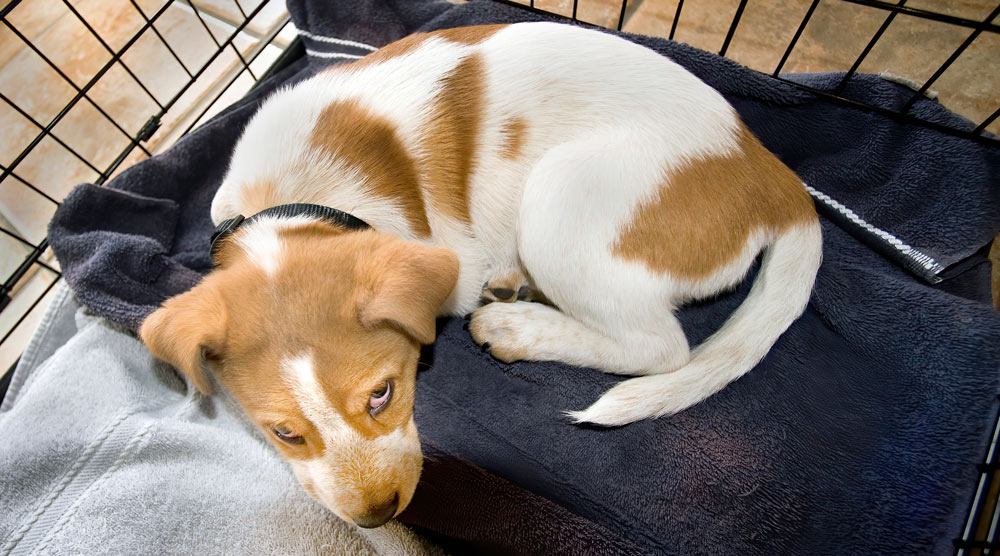
You’ll be one of the lucky ones if your pup is so exhausted after the day’s activities that they sleep right through the night. Most puppies bark, whine, or howl, so be prepared for this.
The first few nights can be the toughest for most pups. They might never have spent a night away from their mother and littermates, and they’re in an alien environment. They also only have little bladders and may need to go potty through the night.
Having a consistent nighttime routine can help, but be prepared for some teething issues. Don’t get frustrated with your pup if they bark or whine a little, or have an accident. The goal is to make the first night as stress-free as possible for your new dog.
Some things that may help your pup settle through the night include:
- Make their crate comfortable and inviting. Soft and warm bedding makes the crate more appealing to your dog. If possible, add a blanket with their mother’s scent on, as this is reassuring for the puppy (most breeders will allow you to drop off some bedding and toys in advance.) You may even want to add a hot water bottle, as this replicates the feeling of sleeping near the mother and littermates. On a side note, never let your puppy sleep in your bed, as this is dangerous and creates bad habits.
- Place the crate where your dog can see you. Even if you don’t plan to have your dog sleeping in your bedroom, place the crate by your bed for the first few weeks. This helps your pup feel they haven’t been abandoned and provides reassurance. It also makes it less likely for the dog to bark. After a few weeks, you can gradually move the crate a bit further away each night.
- No games before bed. Encouraging lots of excited play right before bedtime is only going to mean your dog will be ramped up and less likely to settle. Keep things calm in the hour or so running up to lights out.
- Potty break. Giving your pup the opportunity to pee and poop should be the last thing you do before heading to bed. You’ll also want to set an alarm to get up a few times through the night. Don’t rely on your puppy barking to tell you when they need to go out. Not all puppies will do this, and it also reinforces the habit of barking at night.
It’s natural for your pup to bark or whine a little initially, but if you can ignore it for a short period, they’ll usually settle down.
If they start whining in the middle of the night, they may need the toilet. Whenever you take them out, keep things calm, let them potty, and then bring them straight back to bed. Don’t shower them with attention or play during the night.
Tip: It can help to drop the crate off before it’s time to pick up your puppy, so she has more time to get used to it before coming home. This isn’t always possible, but a reputable breeder/rescue should allow it.
The First Week
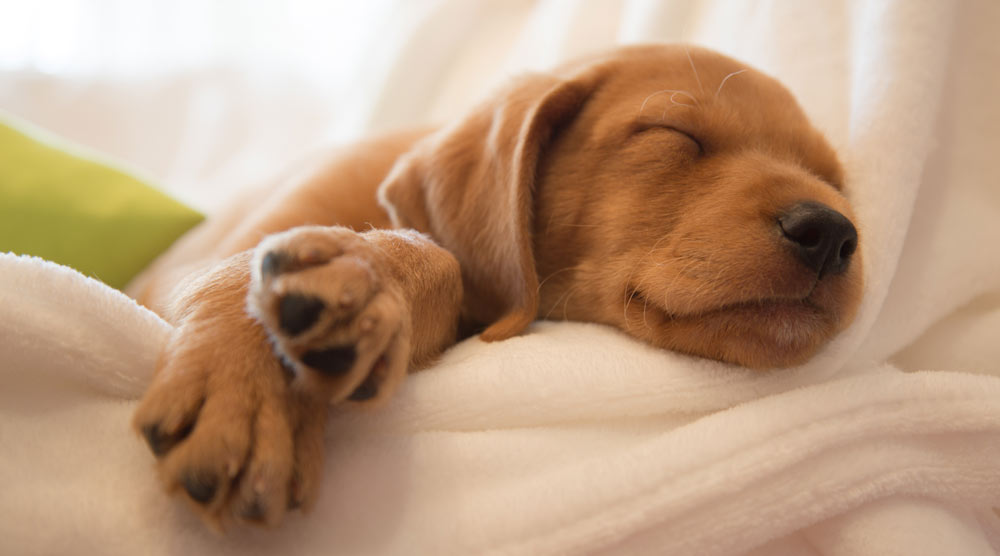
Well done for getting through the first night! The fun is only just beginning though. Here are some important tips for the first week.
Continue to Build a Strong Bond With Your Puppy
Cementing the bond you have with your pup during the first week will help boost their confidence and minimize stress levels. Studies have shown that having a ‘secure base’ encourages dogs to play, interact, and problem-solve more readily.
The key is to spend lots of quality time with your new puppy. Play sessions, positive training, and patience when dealing with behavioral issues are all essential for strengthening your relationship.
Equally, recognizing the subtle signs of stress and ensuring your pup gets space when they need it can build trust.
For more in-depth tips, read our article on how to bond with a new puppy and build a trusting relationship.
Establish a Routine and Be Consistent
Puppies benefit from consistency, as this reduces stress and builds confidence. Establishing a routine when it comes to feeding times, naps, potty breaks, and play will be beneficial to both you and your pup.
Although routines are helpful, don’t be too rigid. If you develop too strict a schedule, it can be difficult to maintain going forward. Your pup may struggle to adjust if you need to change things.
Gradually Mix in Your Dog’s New Food (Optional)
Ideally, when your puppy leaves for their new home, the breeder will have given you a small amount of food or advised you which brand they’re using.
It’s best to keep your pup on this food for at least the first week. A sudden change in a dog’s diet can cause an upset stomach. The last thing you or your pup want to be dealing with while trying to get settled is diarrhea.
If the food isn’t agreeing with your pup, it’s difficult to get hold off, or you want to feed a higher-quality diet, then this should be done gradually over a week to ten days.
For the first few days you should feed around 75% of the old food, then you can do a few days at half and half, before moving to a few days of 75% of the new food.
Once you’re fully switched over, keep an eye on your puppy’s stool consistency. Consistently soft or runny bowel movements could be a sign that the food isn’t agreeing with them, and you may need to try a different diet.
If your dog has diarrhea for more than a day, you should seek advice from your vet. Puppies can become quickly dehydrated, and there could be an underlying issue that needs treatment.
Keep Visitor Introductions Calm and Optional
It’s likely that you’ll have a list of friends and family eager to visit to meet your new puppy. These sorts of visits can be a great opportunity for socialization. However, it’s best to hold off during the first few days, as visitors can be unsettling to your puppy.
When you do have visitors, try not to invite too many people at once, and make sure you have briefed your guests on puppy protocol. Greetings should be calm and on the puppy’s terms. Let the puppy approach when they are ready – don’t place them in someone’s lap or force them to interact. They should always have access to their crate or safe space to allow them to have quiet time if they want it.
Additionally, ask your guests not to offer your pup attention unless they have four paws on the floor. Offer your guest some treats so that they can reward your pup when they do offer a calm sit or settle.
Spend Lots of Time Together (But Slowly Increase Time Apart)
Although it’s important to spend time bonding with your puppy and providing them with lots of enrichment, you also need to help them learn to be confident and independent.
If you take two weeks’ holiday to help your puppy settle in and are with them all the time, it’s understandable that they could suffer from separation anxiety when you have to leave them.
Of course, you should never leave a dog of any age alone all day, but there will be times when you’re out for a few hours.
Even if you are usually home all day, make sure you gradually introduce your pup to alone time. Encourage them to settle in their crate or a puppy pen while you leave the room – even if it’s just for a few minutes to start with.
Help them associate alone time with positive things. Using stuffed treat toys can be a good option.
You can build up the length of time they spend alone over the coming days and weeks. When you do leave the house, start only with a few minutes at a time and don’t make a fuss when you come back in.
Next Steps
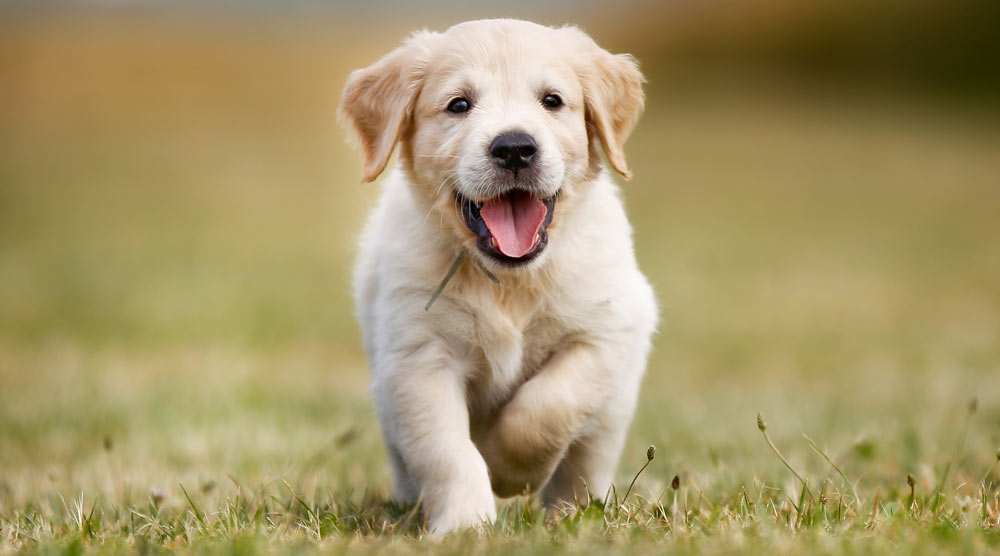
Socialization is Essential!
There’s a critical socialization window during the first three months of your pup’s life. Studies have shown that this can have a great influence on the dog’s future confidence levels, temperament and happiness.
Socialization relates to helping your puppy learn to be comfortable in a variety of situations and environments. It’s about carefully introducing them to new things like other people and animals, places, and lots of different sights, sounds and smells.
Not exposing your pup to a variety of experiences, or doing so inappropriately, can lead to fearfulness, anxiety, avoidance, aggression and other behavioral issues.
Many owners make the mistake of thinking that attending a few puppy parties and getting cuddles with friends is enough. However, your pup needs much more controlled, unforced, and frequent exposure to new stimuli and environments to help them become a well-adjusted adult.
Just some of the things you should work on gradually and positively introducing them to include:
- Lots of different people (including kids and people with beards, umbrellas, hats, and sunglasses)
- The car
- Household appliances
- Other dogs
- Noises like fireworks and sirens
- Cafes and stores (pet-friendly, of course)
- Different walking environments
For more detailed guidance, read our article on how to socialize a puppy. We also have a downloadable puppy socialization checklist which you might find useful.
Book a Positive Puppy Training Class
A well-run puppy class can be a great way for your dog to practice appropriate social interaction with other dogs. Plus, it gives you both an opportunity to learn fundamental training skills.
Steer clear of classes that advocate the use of punishment, force, or aversive tools (things like choke or prong collars). Dogs taught using these methods are more likely to become fearful or aggressive, and it can damage the bond you’re forming with your pup.
Look for classes organized by a qualified dog trainer that promotes reward-based, positive reinforcement methods. Studies show that training using these techniques is more effective and will result in a happier dog too.
Start Basic Training at Home
You don’t need to wait for puppy classes to start before you start your training journey. In fact, starting with the basics at home can be a great way to forge a strong bond, keep your puppy stimulated, and help encourage good behavior. Some of the key commands to focus on include sit, down, stay and recall.
Keep any sessions short, fun and positive. Make sure you have lots of tasty treats and pick the least distracting environment to start with.
Many dogs will perform sit perfectly at home, but struggle outside or when there are distractions. Once your pup has reliably mastered the command at home, it’s important to start working on it in different environments. The technical term for this is generalizing (also sometimes called “proofing”).
Frequently Asked Questions
When Can Friends and Family Visit My Puppy?
It’s tempting to invite friends or relatives around straight away to meet the new family member. While it’s important for your pup to start meeting new people early on for socialization, doing it right away can be too overwhelming.
Allowing your dog at least a few days to become accustomed to their new home and start to bond with their immediate family is recommended. A calm environment can help to reduce stress and build confidence.
When people do start to visit, stick to small groups at first and let the pup approach them at their own pace rather than forcing interactions.
Why Do I Need a Playpen?
Playpens can be a useful tool for new puppy owners. You can’t watch your pup all the time, so having a secure space where you know your puppy is safe can be a lifesaver during the first few months. Filling the pen with toys, comfortable bedding, and fresh water also helps your puppy feel more relaxed when spending time separated from you.
There’s a big difference between a crate and a playpen. Crates are designed to provide a secure and quiet environment for your pet to relax. They are great for sleeping or when your pet feels anxious, but are too small for exercise. Pens are larger, making them a better choice for extended periods during the day.
Summary
Welcoming a new puppy into your home is an exciting and life-changing experience. The bond you can develop is so rewarding.
It’s definitely not a time without challenges, though. New puppies are hard work, and a lot of groundwork is required to ensure they don’t develop bad habits or become overly stressed.
Doing your research and being armed with all the right gear is a big help. It’s also important to take things slowly, don’t overwhelm your puppy, and adopt a positive approach to training. If you nail this, your puppy has the best chance of being happy, well-adjusted and a fantastic new addition to your family.
